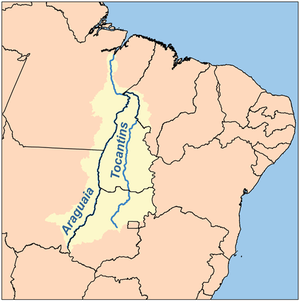Tocantinia mira
This article is about a Brazilian plant. For the Brazilian city of the same name, see Tocantinia.
| Tocantinia | |
|---|---|
| Scientific classification | |
| Kingdom: | Plantae |
| Clade: | Angiosperms |
| Clade: | Monocots |
| Order: | Asparagales |
| Family: | Amaryllidaceae |
| Subfamily: | Amaryllidoideae |
| Subtribe: | Hippeastrinae |
| Genus: | Tocantinia Ravenna[1][2] |
| Type species | |
| Tocantinia mira Ravenna | |

Watershed of Araguaia and Tocantins river systems (yellow), through Tocantins State (outlined), Brazil
Tocantinia is a monotypic genus of herbaceous perennial bulbous plants flowering plants in the Amaryllis (Amaryllidaceae) family, subfamily Amaryllidoideae. The sole species is Tocantinia mira.
Description
Flowers are single, the stigma capitate. Spathe bracts are lanceolate, with a single valve.[3][4]
Taxonomy
Once placed in its own tribe (Tocantinieae) by Ravenna, it is now located in subtribe Hippeastrinae of tribe Hippeastreae.[1] The sole species is Tocantinia mira, which is found in central Brazil (Tocantins State).[2][5][3]
Distribution and habitat
Tocantinia mira grows in a dry forest between the rivers Araguaia and Tocantins.[6]
References
Bibliography
- "The Plant List: a working list of all known plant species. Version: 1.1". Royal Botanic Gardens, Kew and Missouri Botanical Garden. September 2013.
- "World Checklist of Selected Plant Families". Royal Botanic Gardens, Kew. Retrieved 8 August 2015.
- García, Nicolás; Meerow, Alan W.; Soltis, Douglas E.; Soltis, Pamela S. (1 March 2014). "Testing Deep Reticulate Evolution in Amaryllidaceae Tribe Hippeastreae (Asparagales) with ITS and Chloroplast Sequence Data". Systematic Botany. 39 (1): 75–89. doi:10.1600/036364414X678099.
- Ravenna, P. F. (2000). "Tocantinia and Cearanthes, two new genera, and Tocantinieae new tribe, of Brazilian Amarylidaceae". Onira. 5 (3): 9–43.
- Byng, James W. (2014). The Flowering Plants Handbook: A Practical Guide to Families and Genera of the World. Plant Gateway Ltd. ISBN 978-0992999308.
- "Pacific Bulb Society". Pacific Bulb Society. 2012. Retrieved 9 February 2016.
External links
- Tocantinia at JSTOR
| Wikispecies has information related to: Tocantinia |
This article is issued from Wikipedia - version of the 7/18/2016. The text is available under the Creative Commons Attribution/Share Alike but additional terms may apply for the media files.